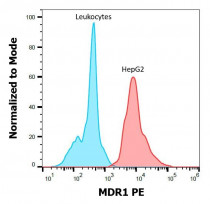ARG42284
anti-MDR1 / P Glycoprotein 1 antibody [UIC2] (PE)
anti-MDR1 / P Glycoprotein 1 antibody [UIC2] (PE) for Flow cytometry and Human
Overview
| Product Description | PE-conjugated Mouse Monoclonal antibody [UIC2] recognizes MDR1 / P Glycoprotein 1 |
|---|---|
| Tested Reactivity | Hu |
| Species Does Not React With | Ms, Rat |
| Tested Application | FACS |
| Specificity | The mouse monoclonal antibody UIC2 recognizes an extracellular epitope on CD243 (MDR-1), an approximately 170 kDa ABC transporter expressed on hematopoietic stem cells, B, T, and NK cells, or on many multidrug resistant cancer cells. This antibody preferentially recognizes CD243 in the process of transporting substrate. |
| Host | Mouse |
| Clonality | Monoclonal |
| Clone | UIC2 |
| Isotype | IgG2a, kappa |
| Target Name | MDR1 / P Glycoprotein 1 |
| Antigen Species | Human |
| Immunogen | NIH/3T3 cells transfected with Human MDR1 cDNA. |
| Conjugation | PE |
| Alternate Names | PGY1; ABC20; P-GP; ATP-binding cassette sub-family B member 1; Multidrug resistance protein 1; CD antigen CD243; GP170; CLCS; CD243; MDR1; EC 3.6.3.44; P-glycoprotein 1 |
Application Instructions
| Application Suggestion |
|
||||
|---|---|---|---|---|---|
| Application Note | * The dilutions indicate recommended starting dilutions and the optimal dilutions or concentrations should be determined by the scientist. |
Properties
| Form | Liquid |
|---|---|
| Purification | Purified |
| Buffer | PBS and 15 mM Sodium azide. |
| Preservative | 15 mM Sodium azide |
| Storage Instruction | Aliquot and store in the dark at 2-8°C. Keep protected from prolonged exposure to light. Avoid repeated freeze/thaw cycles. Suggest spin the vial prior to opening. The antibody solution should be gently mixed before use. |
| Note | For laboratory research only, not for drug, diagnostic or other use. |
Bioinformation
| Database Links | |
|---|---|
| Gene Symbol | ABCB1 |
| Gene Full Name | ATP-binding cassette, sub-family B (MDR/TAP), member 1 |
| Background | The membrane-associated protein encoded by this gene is a member of the superfamily of ATP-binding cassette (ABC) transporters. ABC proteins transport various molecules across extra- and intra-cellular membranes. ABC genes are divided into seven distinct subfamilies (ABC1, MDR/TAP, MRP, ALD, OABP, GCN20, White). This protein is a member of the MDR/TAP subfamily. Members of the MDR/TAP subfamily are involved in multidrug resistance. The protein encoded by this gene is an ATP-dependent drug efflux pump for xenobiotic compounds with broad substrate specificity. It is responsible for decreased drug accumulation in multidrug-resistant cells and often mediates the development of resistance to anticancer drugs. This protein also functions as a transporter in the blood-brain barrier. Mutations in this gene are associated with colchicine resistance and Inflammatory bowel disease 13. Alternative splicing and the use of alternative promoters results in multiple transcript variants. [provided by RefSeq, Feb 2017] |
| Function | Translocates drugs and phospholipids across the membrane (PubMed:8898203, PubMed:2897240, PubMed:9038218). Catalyzes the flop of phospholipids from the cytoplasmic to the exoplasmic leaflet of the apical membrane. Participates mainly to the flop of phosphatidylcholine, phosphatidylethanolamine, beta-D-glucosylceramides and sphingomyelins (PubMed:8898203). Energy-dependent efflux pump responsible for decreased drug accumulation in multidrug-resistant cells (PubMed:2897240, PubMed:9038218). [UniProt] |
| Cellular Localization | Cell membrane; Multi-pass membrane protein. [UniProt] |
| Calculated MW | 141 kDa |
Images (1) Click the Picture to Zoom In






